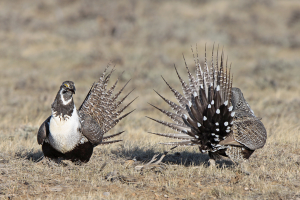The sage-grouse front
By Garett Reppenhagen
From The Hill
I had to wrack my brain to be sure, but I am: In all my time in the military, including as a sniper inIraq, I can’t recall a sage-grouse being a part of my unit, or any unit. And I certainly cannot recall any sage-grouse being dishonorably discharged or selling military secrets to our enemies.
The only reason I went back to make sure of that is because, somehow, language aimed at ending protection of the bird and its habitat has been submitted as an amendment to the National Defense Authorization Act, which funds our military, and takes care of the men and women in it.
While there are a lot of people working on conservation of the bird, and obviously some opposed, that’s not the issue. The issue is using an inappropriate venue to advance a political agenda of some western legislators on the backs of men and women in uniform.
Understanding that a stand-alone bill is likely dead, the sage-grouse amendment’s sponsor, Rep. Rob Bishop (R-Utah), seems bent on shoe-horning in his political will on the rest of the nation, while doing nothing to advance the cause of better funding for ground forces, better pay for active duty personnel or restoring housing allowance cuts that put our military forces close to the poverty line. That is what the focus of the NDAA should be—not sage-grouse.
Regardless of all of that, the military has successfully been working to protect vital habitat for sensitive species for decades, anyway. Endangered red-cockaded woodpeckers have co-existed at Camp Lejeune with Marines since 1970 – even longer than the Endangered Species Act has been in existence. Despite the rhetoric from the amendment’s sponsor, the military can, has, and will continue to coexist with the indigenous animal population around its training grounds. It simply isn’t a very big deal.
In fact, Joshua Brandon, Project Cohort Program Manager, former Army Infantry Officer, and three-time Iraq veteran, recently spoke to the sage-grouse directly: “In the four years I trained for combat operations at the Yakima Training Center in Washington as an infantry company commander and battalion operations officer, the sage-grouse never once negatively impacted our unit training and combat readiness. Even during times of increased operational tempo, with multiple units constantly using the training center, we worked with local land managers to alter the execution of our training to account for the sage-grouse restrictions.
Combining operational adaptability with a bit of imagination, we were able to conduct major live fire operations on alternate sites, and when the sage-grouse restricted areas were in required training areas, we altered the scenario to regard these zones as sensitive cultural sites, minefields, or severely restrictive terrain that actually enhanced our younger leader’s operational training experience.”
When you consider the facts, it is clear that the sage-grouse is one of the many issues tacked onto the NDAA that are not relevant to America’s security needs. As a result, one of the most important bills in Washington is at risk of being packed with favors for special interests. Americans, and our men and women in uniform, know this bill is too important to be meddled with. It should be focused on our military’s need – not the needs of special interest groups.
It’s a sad commentary on a sad time in Washington that hot meals for our troops have to take a back seat to one legislator’s campaign against a western bird. Just when you think Congress’ approval ratings can’t get any lower, they go and try to pull a stunt like this.
If we must address the issue of the sage-grouse, now, then the best possible option is for all stakeholders – federal agencies (like the Bureau of Land Management, the Dept. of Agriculture, and the U.S. Fish and Wildlife Service), state agencies, local governments, sportsmen, ranchers, businesspeople, and private landowners – work together to create viable management plans to protect sage grouse habitat and bolster sage-grouse populations.
At the first sign of the sage-grouse’s interest in joining al Qaeda, or even if it just leaves its post without permission from a superior, we can talk about ending protections for the bird as a part of the military funding bill. Heck, if a sage-grouse forgets to bring extra socks and won’t shut up about its feet, I might even write a whole op-ed about how we should end protection for it.
Until that time, the best option for our military is for leaders like Rep. Bishop to set aside special interest politics when setting our most important priorities.
Reppenhagen served as a U.S. Army cavalry scout sniper in the 1st Infantry Division in Kosovo and Iraq and currently works as the Rocky Mountain director of Vet Voice Foundation.

